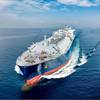On March 6, 2004, the small passenger vessel Lady D, a pontoon water taxi with 2 crewmembers and 23 passengers on board, was en route from Fort McHenry to Fells Point, Maryland, when it encountered a rapidly developing storm with high winds. The pontoon vessel began to roll in the waves and eventually continued over onto its starboard side and capsized. Personnel from the Naval Reserve Center Baltimore, a Navy training installation adjacent to Fort McHenry, witnessed the capsizing, called 911 to report the accident, and then launched a vessel to the scene to render assistance. Responders were able to rescue or recover all but 3 occupants of the Lady D within an hour of the accident. The bodies of the remaining victims were recovered from the waterway on March 14 and 15. As a result of this accident, 5 passengers died; 4 passengers suffered serious injuries; and 12 people sustained minor injuries. Vessel damage was estimated at $35,000.
The Safety Board’s investigation of this accident identified major safety issues in the following areas:
• Passenger weight criteria for stability assessment;
• Pontoon vessel stability standards; and
• Policies and procedures pertaining to weather operations.
The National Transportation Safety Board determines that the probable cause of the capsizing of the pontoon-style small passenger vessel Lady D was its lack of intact stability, which was insufficient to withstand the strong winds and waves that the boat encountered. The lack of intact stability was caused by overloading, which resulted from a combination of the following:
• The Lady D was erroneously granted sister status by the U.S. Coast Guard to a pontoon vessel with different design characteristics;
• The Coast Guard certificated the Lady D to carry too many people as a result of an inappropriate stability test on the vessel to which it was granted sister status; and
• The Coast Guard’s regulatory stability test standards on which the Lady D’s passenger allowance was based use an out-of-date average passenger weight.
As a result of this investigation, the Safety Board makes recommendations to the U.S. Coast Guard.
Featured videos

Inmarsat Enhances Service to Drive Digitalization

Tracking Foreign Vessels Working in the U.S. Jones Act Market

Inside the Electrified Truckable Tug
Subscribe for
Maritime Reporter E-News
Maritime Reporter E-News is the maritime industry's largest circulation and most authoritative ENews Service, delivered to your Email five times per week









